Review GSM phone Samsung X620
Samsung
X620. Live pictures
Package:
- Handset
- Battery
- Charger
- Wire stereo headset
- Manual
The X series brought us the X100 in the classical form-factor, which was one of the most successful models, and the X600, which didn't get as popular though having high sale. The company decided on endowing the X series with the most attractive design and making the series the shock of its model line. Just remember the X700 built on a new platform and providing with wide capabilities. So, in connection with this, the X620 is interesting to look at, which on the one hand refers to the new concept if judging the design and the number and on the other hand is built by analogy with Samsung X600.

The hone design corresponds with the last company solutions - lacquered plastic, moderate forms and a strict appearance. Unlike the elder models, the plastic on both sides and the back is different coloured in dark silvery. This dissonance is explained with the phone's positioning - it's cheap though is to put on a false front and look more expensive. The size is quite comfortable 106x45.5x20 mm, and the weight is 81 gram. The lacquering serves not the best in everyday use, since prints of fingers and your neck will still stay on the body. And the screen glass matches the whole front panel - it is toned. On the one hand, it makes the screen more readable in the sun, but on the other hand it is faster soiled. The keypad hides fingerprints due to the wave-like form.
What can help saving money in a middle class phone? Right you are, the screen! In the Х620 it belongs to the last generation, but has the resolution of 128x160 pixels (28x34 mm), which gives way to the last company models. At the same time the type of this screen is TFT, and also it shows 65K colours. The picture quality is good, the colours are saturated, though some pixels are a bit degraded. In its segment the screen is acceptable though loosing to Sharp models (integrated into the majority of Motorola's phones - 176x220 pixels). Fading in the sun, it still remains readable. This screen holds up to 5 text lines and up to 3 service ones. Unfortunately, the low resolution made the developers increase the font-size and make the fonts bold. In various conditions it is easy to make out, though not all the tips fit the screen, then you'll have to use scrolling (notes are automatically scrolled on the display).

The plastic keypad is rather comfortable. The close button disposition will please only some people, but the real disadvantage is the size of the navi button - it's too little. And an OK one integrated into it. The backlighting is white being the brightest for the first horizontal row. Characters on the buttons are well seen in every condition.


The left side holds coupled volume button and an IrDA gap below (it sends pictures and melodies only with the help of special software, no direct sending). The right side shows the headset connector closed with a shutter fixed to the body. And a camera button is also there.

A strap hole is on the top, and a standard interface connector features the bottom end. On the back you'll see a mirror and a VGA-camera objective.
The battery also serving as the back is fixed with only one catch and has no backlash. The Li-Ion battery is capacious of 800 mAh. As the manufacturer claims, it is capable of up to 300 hours in the standby mode and up to 6.5 hours in the talk one. In Moscow networks we could use the device for about 3 days in case of an hour of talks and about 20 minutes of using other functions (mainly games). Total time for recharging forms 1.5 hours.
Menu
The dynamical memory block shared by all the applications in the phone reaches 3 MB. That is extremely little and untypical both of the last Samsung's models and others. Not much memory is necessary due to the absence of MP3 support, though such a device still looks archaic.

The interface is designed like the last company models, but inside it is similar to the previous generation of phones. The main menu is a set of icons, and number navigation is present,

Phonebook. Up to a 500 phone numbers can be stored in the phone memory. Up to five phone numbers and e-mail can be added to each name. All phone numbers can be organized in up to six caller groups (totally 5 of them). It's possible to assign a melody or a picture to each entry.





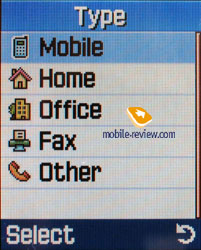



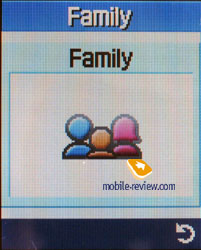


Horizontal scrolling allows listing bookmarks and viewing the phone numbers. Both phone numbers from SIM-card and phone memory are displayed in the total list. You can search by name and need only to enter the first letters of the name to look it up.
You can set up to nine speed-dial numbers.
Messages. There are two separate choices, which allow sending/receiving SMS and MMS messages relatively. Up to 200 SMS-messages can be stored in the phone, and there are up to nine editable SMS-templates. The phone also supports EMS which enables you to add pictures, animations and melodies to your SMS. The set of files you can use are the same as on the average Samsung phone and there are no changes compared to other models..
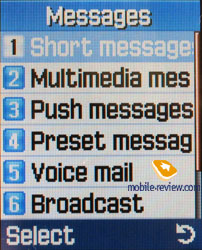


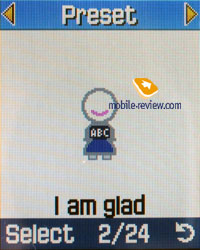
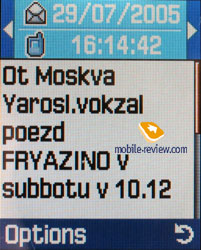

Work with MMS-messages is standard. When you create a message, a template with fields to input text, music, picture and theme appear. You can create several pages, set the display time between them and adjust font (size, style). The maximum size of an MMS-message is limited to 90 Kb.


There is a special folder for drafts and sent messages.
Call records. 20 missed, 20 received and 20 dialed calls can be listed in the phone. Time and date of each call is indicated in this menu. You can also view the time spent in the last call as well as total time of all incoming and outgoing calls.



Sounds. The phone supports 40-tones polyphony, which doesn't sound bad at all! There are several modes of alerts, i.e. only sound or only vibracall finishing with a melody, but you can also select silent mode (only vibra). Other settings are pretty standard. You can select signal tones for SMS-messages, MMS-messages and enable a minute minder which keeps the time-flying at bay when in a conversation.


Settings. Apart from choosing greeting messages, here's where you adjust the display settings. You can set an animation (up to 5 pre-default ones) as a wallpaper, and it's possible to select which font style to use and location of the text.










One of the two color schemes is available.
Duration of backlighting can be also altered (from 15 seconds to 10 minutes). The longest choice is probably interesting for those who like to play games, and in this case won't have to push the keys to reactivate backlighting while playing a game. Game ON!
There are up to 5 levels of brightness in the screen.
Organizer. You can easily add a new reminder - each up to 100 characters. After inputting text, you can select one of the following categories - schedule, to-do list, call, anniversary. Depending on your choice, different actions will be available. For example, if you select a schedule, you will see a calendar, then be able to select a date and time and finally set the alarm-clock. Afterwards this record will be saved and displayed in a separate window. An almost (well) unlimited number of records can be added to each day, with totally up to 25 records of each category available. When you view several records added for one day, you can see the numbers of records input. Overall, the organizer is well-planned.
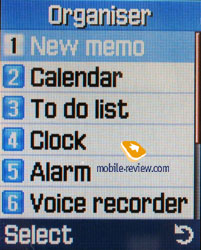



The world time functions are conventional. The same goes for the calculator, unit converter and currency converter. A countdown timer and a stopwatch with a lap-by-lap feature are also available in the phone.





The alarm-clock doesn't support simultaneous set alarms. The user can use an autopower on/off function thus the alarm-clock is active even if the phone is switched off.


Using the dictaphone you will record up to 1 hours records even during a conversation. The number of the records is not limited

Network Services. Just settings - calls diverting, choice of operator etc.
Fun Box. A Wap-browser of the 2.0 version is located here and allows viewing of color images. The phone supports GPRS 4+2 which means you won't have to pay much for browsing.
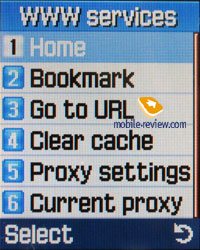
All received pictures, images and melodies are kept in the Media Box.

There are two pre-installed games in the phone: SnowBallFight and BubbleSmile. There is no special memory slot for Java, and only the same 3 MB are still available.




FM-radio. You can use memory for 10 stations and a Pop up Alert, which is some kind of an alarm clock playing with radio. The realization roused no cavils and is subjectively better than in Samsung X140.
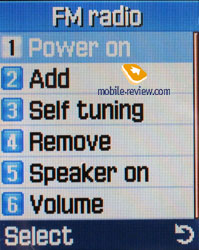

Camera. It is the last menu item in the phone. To start shooting just press the joystick to the right (in the open phone mode). Images of different resolutions (640x480, 320x240, 160x120, and 128x120) can be taken using this camera. There are several types of compression for each of the resolutions (files are stored in JPEG format): Super Fine, Fine, Normal and Economy. The difference is visible on the large images of the highest resolution. Super Fine image size is about 90-95 Kb, Economy image occupies about 40 Kb. In other resolutions the differences are also seen.


You can view your photos in the photo album, as thumbnails in particular. Some images can be locked from occasional deleting. There is an opportunity to move several images to own albums.
The user sees a picture on the screen while shooting. Deflecting navigation key, you can zoom in or zoom out a picture (5-x digital zoom). Horizontal movements allow adjusting matrix photosensitivity (from -3 to +3).
The camera quality is typical for this class, no peculiarities. Video is not recorded.
Impressions
The device has no problems with reception quality and the corresponding voice is audible enough in the speaker. The volume of the 40-tones polyphonic ringer is high which is a big advantage. Melodies sound nice and the vibrating alert is stronger than average.





The advantages we can name are no MP3 support and little memory. At the same time there is a fully-functional dictaphone and the appearance untypical of this class. The model will be launched in October for about 150-160 USD. For this money it seems not bad, though still loses to Motorola L6 in fashion component. At the same time active advertising support will have done its part. The device is pleasant to deal with, though not offering anything extraordinary - just a good phone for calls. No specific problems are present, since the platform is well worked out and known by the previous models.
Eldar Murtazin (eldar@mobile-review.com)
Translated by Maria Mitina (maria.mitina@mobile-review.com)
Published — 25 August 2005
Have something to add?! Write us... eldar@mobile-review.com
|




































































